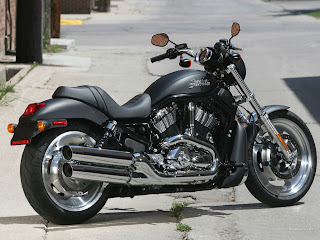Harley-Davidson often abbreviated H-D or Harley, is an American motorcycle manufacturer. Founded in Milwaukee, Wisconsin, during the first decade of the 20th century, it was one of two major American motorcycle manufacturers to survive the Great Depression. Harley-Davidson also survived a period of poor quality control and competition from Japanese manufacturers.
The company sells heavyweight (over 750 cc) motorcycles designed for cruising on the highway. Harley-Davidson motorcycles (popularly known as "Harleys") have a distinctive design and exhaust note. They are especially noted for the tradition of heavy customization that gave rise to the chopper style of motorcycle. Except for the modern VRSC model family, current Harley-Davidson motorcycles reflect the styles of classic Harley designs. Harley-Davidson's attempts to establish itself in the light motorcycle market have met with limited success and have largely been abandoned since the 1978 sale of its Italian Aermacchi subsidiary.
Harley-Davidson sustains a loyal brand community which keeps active through clubs, events, and a museum. Licensing of the Harley-Davidson brand and logo accounted for $40 million (0.8%) of the company's net revenue in 2010.
Models:
- 1907- Single cylinder model with 26.84 cubic inches (440cc)
 |
| 1907 model. |
In February 1907 a prototype model with a 45-degree V-Twin engine was displayed at the Chicago Automobile Show.
Big V-twins:
- F-head- also known as JD, pocket valve and IOE (intake over exhaust), 1914–1929 (1,000 cc), and 1922–1929 (1,200 cc)
- Flathead- 1930–1948 (1,200 cc) and 1935–1941 (1,300 cc).
- Knucklehead- 1936–1947 61 cubic inch (1,000 cc), and 1941–1947 74 cubic inch (1,200 cc)
- Panhead- 1948–1965 61 cubic inch (1,000 cc), and 1948–1965, 74 cubic inch (1,200 cc)
- Shovelhead- 1966–1984, 74 cubic inch (1,200 cc) and 80 cubic inch (1,345 cc) since late 1978
- Evolution- (a.k.a. "Evo" and "Blockhead"), 1984–2000, 80 cubic inch (1,340 cc)
- Twin Cam 88- (a.k.a. "Fathead") 1999–2006, 88 cubic inch (1,450 cc)
- Twin Cam 88B- (counter balanced version of the Twin Cam 88) 2000–2006, 88 cubic inch (1,450 cc)
- Twin Cam 95- since 2000, 95 cubic inch (1,550 cc) (engines for early C.V.O. models)
- Twin Cam 96- since 2007, 96 cubic inch (1,584 cc)
- Twin Cam 103- 2003–2006, 2009, 103 cubic inch (1,690 cc) (engines for C.V.O. models), Standard on some 2011 Touring models such as the Road King Classic and Road Glide Ultra and optional on other Touring Models like the Road Glide Custom and Street Glide.
- Twin Cam 110- since 2007, 110 cubic inch (1,802 cc) (engines for C.V.O. models)
 |
| Harley produced the WLC for the Canadian military. |
Small V-twins:
- D Model- 1929–1931, 750 cc
- R Model- 1932–1936, 750 cc
- W Model- 1937–1952, 750 cc, solo (2 wheel, frame only)
- G (Servi-Car) Model- 1932–1973, 750 cc
- K Model- 1952–1953, 750 cc
- KH Model- 1954–1956, 900 cc
- Ironhead- 1957–1971, 900 cc; 1971–1985, 1,000 cc
- Evolution- since 1986, 883 cc, 1,100 cc and 1,200 cc
 |
| Harley Davidson VRSCA - V - Rod |
Current model designations:
Sportster- With the exception of the street-going XR1000 of the 1980s and the XR1200 most Sportsters made for street use have the prefix XL in their model designation. For the Sportster Evolution engines used since the mid 1980s, there have been two engine sizes. Motorcycles with the smaller engine are designated XL883, while those with the larger engine were initially designated XL1100. When the size of the larger engine was increased from 1,100 cc to 1,200 cc, the designation was changed accordingly from XL1100 to XL1200. Subsequent letters in the designation refer to model variations within the Sportster range, e.g. the XL883C refers to an 883 cc Sportster Custom, while the XL1200S designates the now-discontinued 1200 Sportster Sport.

Harley-Davidson Sportster 1200 Dyna- Models utilize the big-twin engine (F), small-diameter telescopic forks similar to those used on the Sportster (X), and the Dyna chassis (D). Therefore, all Dyna models have designations that begin with FXD, e.g., FXDWG (Dyna Wide Glide) and FXDL (Dyna Low Rider).

Harley-Davidson Dyna Softail- Models utilize the big-twin engine (F) and the Softail chassis (ST).

Harley Davidson Softail Fat
Touring- Models use Big-Twin engines and large-diameter telescopic forks. All Touring designations begin with the letters FL, e.g., FLHR (Road King) and FLTR (Road Glide).

Harley-Davidson Touring VRSC- Models utilize the Revolution engine (VR), and the street versions are designated Street Custom (SC). After the VRSC prefix common to all street Revolution bikes, the next letter denotes the model, either A (base V-Rod: discontinued), AW (base V-Rod + W for Wide with a 240 mm rear tire), B (discontinued), D (Night Rod: discontinued), R (Street Rod: discontinued), SE and SEII(CVO Special Edition), or X (Special edition). Further differentiation within models are made with an additional letter, e.g., VRSCDX denotes the Night Rod Special.

Harley-Davidson VRSC- V Rod
*Updated on 11th Aug 2011





